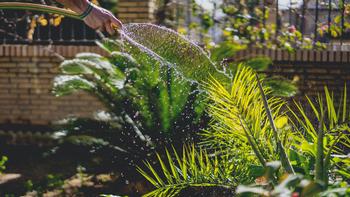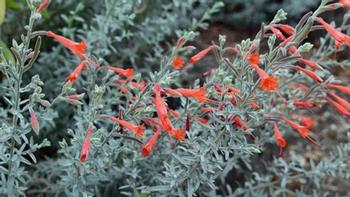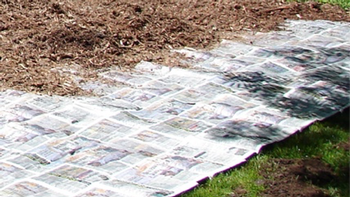Fall 2023
Gardener's checklist for fall
SEPTEMBER

- Reduce irrigation times as day length shortens and plant growth slows.
- Add garden waste, grass clippings, pruning material, and leaves to your compost so long as they are not diseased. Turn compost and keep it as moist as a wrung-out sponge.
- Refresh the spring application of mulch to bring it to two to four inches.
Planting and propagating
- Divide overgrown perennials as they finish blooming. Before replanting them, weed and amend garden beds.
- Renovate lawn by seeding bare spots, dethatching, and fertilizing. Consider replacing or reducing lawn area. Learn more about lawn care.
- Plant ornamental grasses, shrubs, perennials, evergreens, and groundcovers.
Cutting and pruning
- Cut strawflowers, statice, yarrow, and other flowers that preserve well. Hang them to dry for use in arrangements.
- Prune evergreen, summer-flowering shrubs.
Pests and weeds
- Reduce spider mites, scale, and other insect pests by taking houseplants outside and spraying them down with the hose in a part shade area. Keep the foliage dust free to discourage indoor pests.
- Use caulk to seal entries that ants may use to enter your home.
- Manage aphids and scale on outdoor and indoor plants to discourage ants.
Feed and fertilize
- Fertilize houseplants if needed.
- Feed azaleas, camellias, and rhododendrons with an organic fertilizer with no nitrogen.
- Feed citrus for the last time of the year, if needed.
Edibles
- Plant cover crops to improve soil structure and fertility.
- Plant artichokes, arugula, cauliflower, celery, chard, collard greens, kale, lettuce, bunching onions, and peas.
- Learn more about crops to plant in September and other activities in the edible garden.
Fire-smart Landscaping
- Clear leaf and needle litter from gutters, roof, eaves, and vents.
- Clear branches 10 feet from the roof and chimney.
- Learn more about Fire-smart Landscaping.
OCTOBER

- Reduce irrigation times significantly as day length shortens and plant growth slows or stops.
- Clean up diseased and damaged plant materials so pathogens don’t overwinter.
- Add garden waste, grass clippings, pruning material, and leaves to compost so long as they are not diseased. Turn compost and keep it as moist as a wrung-out sponge. Cover before rains start to retain moisture; cover during rainy weather to avoid the pile becoming waterlogged.
- Add compost and organic soil amendments but don’t disturb shallow-rooted plants.
- Refresh the spring application of mulch to bring it to two to four inches. (Avoid thicker layer of bark mulch as it may hide smoldering embers in the event of a nearby fire.)
- Clean garden tools. Disease microorganisms may also overwinter on the surface of stakes, tomato cages, trellises, and other garden equipment. Remove all soil from the tools and clean them with a 10% bleach solution or other disinfectant to protect your tools from spreading diseases. Apply a light layer of oil to prevent rusting if you will not be using them for a while. Wash garden gloves.
- Visit nurseries to see trees and shrubs with outstanding fall color; determine if there’s a place in your garden that would benefit from one of these selections.
Planting and propagating
- Plant California natives. This is the perfect time.
- Reseed bare spots in your lawn or install sod. Consider reducing or replacing your lawn to conserve water.
- Plant ornamental grasses, shrubs, perennials, evergreens and groundcovers. Winter rains will help establish sturdy root systems.
Cutting and pruning
- Lightly prune Japanese maples while still in leaf. Select and plant maples; now is the time to see fall color.
- Prune deciduous trees and shrubs that need pruning such as crape myrtle, rose, and Spirea
Pests and weeds
- Visit your garden after dark with a flashlight and handpick snails and slugs. Control measures in fall help reduce populations in spring.
Feed and fertilize
- Feed azaleas, camellias and rhododendrons with an organic fertilizer with no nitrogen.
- Change feeding program for cymbidium. During the fall and winter, use a formula with low nitrogen and higher potassium and phosphorus monthly to promote more and bigger blooms.
Edibles
- Continue with last of summer harvest.
- Plant artichokes, arugula, kale, garlic, shallots, and lettuce.
- Learn more about crops to plant in October and other activities in the edible garden.
Fire-smart Landscaping
- Learn more about Fire-smart Landscaping.
NOVEMBER

- Mulch bare soil to hold in moisture, keep out weeds, and prevent compaction by hard rains.
- Clean up the garden before the rains begin. Remove leaves and debris from under and around plants.
- Create new planting areas by sheet mulching over weed patches or unwanted lawn.
- Turn off irrigation system for the season; continue to water plants under overhangs.
- Protect sensitive plants from cold injury when frost is predicted. Water the garden if it hasn’t rained recently. (Do not water succulents if frost is in the forecast.)
- Clean and store any unused pots and containers that can be used as hiding places by overwintering insects, slugs, and spiders.
- Clean garden tools. Disease microorganisms also overwinter on the surface of stakes, tomato cages, trellises, and other garden equipment. Remove all soil from the tools, and clean them with a 10% bleach solution or other disinfectant to protect tools from spreading diseases. Apply a light layer of oil to prevent rusting if you will not be using them for a while. Wash garden gloves.
Planting and propagating
- Plant shrubs, perennials, and trees. Fall is for planting! Winter rains will help develop a strong root system.
- Plant spring blooming bulbs.
- Plant California natives. Late fall, just as the rains start, is the best time for planting natives and scattering seeds of annual wildflowers.
- Dig, divide, and replant overgrown perennials for more profuse blooms next spring.
- Plant bulbs for spring color, including daffodils, crocus, freesia and hyacinths.
- Remove all but one fat bud from each camellia stem for larger blooms.
Cutting and pruning
- Lightly prune Japanese maples while still in leaf. Select and plant maples for fall color.
- Remove dead, broken, or diseased limbs from trees and shrubs.
Pests and weeds
- Do not compost debris from fuchsias, roses, and the camellia/rhododendron/azalea family, as they can spread a variety of fungi and molds and allow undesirable insects to overwinter.
- Manage rainy season weeds before they flower using non-chemical methods such as cultivation, hand weeding, or mowing. Use toxic chemicals only as a last resort.
Edibles
- Plant garlic, shallots, and peas.
- Learn more about crops to plant in November and other activities in the edible garden.
Fire-smart Landscaping
- Create adequate spacing of trees and shrubs in your garden to minimize the transmission of fire from one plant to another and ultimately to your house.
- Learn more about Fire-smart Landscaping.
